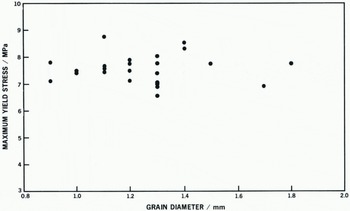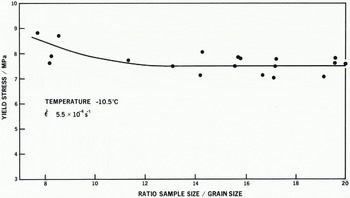The Editor,
Journal of Glaciology
Sir,
In their recent paper Reference Duval and Le GacDuval and Le Gac (1980) show that the permanent creep-rate of polycrystalline ice does not increase with grain-size. We wish to agree with their conclusion by presenting data we have collected at higher strain-rates (5.5 × 10−4 s−1), on laboratory-grown, randomly oriented, polycrystalline ice tested at a constant strain-rate in compression. Figure 1 shows the maximum yield stress reached as a function of grain-size, for the, albeit narrow, range of grain-sizes from 0.8 to 1.8 mm diameter. No significant effect of grain-size is seen. We are extending the results to smaller grain-sizes, but are having difficulty in obtaining small-grain ice which is also air free. We cannot go to much larger grain-sizes because our sample diameter is fixed at 20 mm and our results (Fig. 2) show that the sample diameter should be approximately 12 times the grain diameter for the maximum yield stress to be independent of grain-size. For this reason Duval and Le Gac should be cautious in interpreting their results from samples greater than 7 mm diameter when their sample size is 80 mm. The same comment applies to Reference BakerBaker’s (1978) original work.

Fig. 1. The maximum yield stress plotted against grain-size, for laboratory-grown polycrystalline ice tested at −10.5°C strain-rate 5.5 × 10−4 s−1, sample diameter 20 mm, sample length 60 mm.

Fig. 2. The maximum yield stress plotted against the ratio of sample size to grain-size. The grain-size was kept constant at 1.0 mm and the sample diameter was varied. Below a ratio of 12 the yield stress depends on this ratio.






